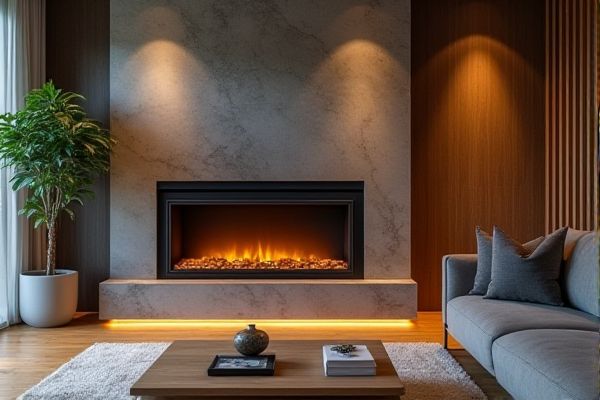
Electric fireplaces offer convenience, easy installation, and adjustable heat settings with minimal maintenance, while wood fireplaces provide a traditional ambiance and the authentic experience of burning real wood but require more upkeep and consistent fuel supply. Explore the rest of this article to understand which fireplace suits your home's needs and your lifestyle best.
Table of Comparison
| Feature | Electric Fireplace | Wood Fireplace |
|---|---|---|
| Installation | Easy, plug-in or built-in | Requires chimney and professional setup |
| Heat Output | Up to 4,600 BTU | Up to 80,000 BTU |
| Maintenance | Minimal, occasional cleaning | Regular chimney cleaning and ash removal |
| Environmental Impact | Zero emissions during use | Produces smoke and particulate emissions |
| Cost | Lower upfront and operational costs | Higher cost due to fuel and maintenance |
| Operation | Simple remote or switch control | Manual fire building and monitoring |
| Safety | Cool to touch, safe around children | Fire hazard risk, requires precautions |
| Ambiance | Simulated flame effect | Authentic wood flame and crackle |
Introduction to Electric and Wood Fireplaces
Electric fireplaces offer a clean, energy-efficient alternative with easy installation and no need for ventilation, making them ideal for modern homes. Wood fireplaces provide a traditional ambiance and authentic crackling sound but require a chimney, regular maintenance, and a steady supply of firewood. Both options vary significantly in environmental impact, operational cost, and installation complexity.
Energy Efficiency Comparison
Electric fireplaces offer higher energy efficiency, converting nearly 100% of electricity into heat without wasted emissions, while wood fireplaces lose significant heat through the chimney. Wood fireplaces burn fuel inefficiently, with only about 10-30% of the wood's energy converted into usable heat for the room. The clean combustion of electric fireplaces provides consistent warmth and reduced energy costs compared to the variable efficiency of wood-burning alternatives.
Installation and Maintenance Requirements
Electric fireplaces offer straightforward installation with no need for chimneys, vents, or professional contractors, making them ideal for various room types. In contrast, wood fireplaces require extensive installation, including chimney construction and ventilation, which involves higher costs and structural modifications. Maintenance for wood fireplaces demands regular chimney cleaning and ash removal to prevent fire hazards, whereas electric models only require occasional dusting and minimal upkeep.
Environmental Impact and Sustainability
Electric fireplaces produce zero direct emissions and have a significantly lower environmental impact compared to wood fireplaces, which release particulate matter and carbon dioxide contributing to air pollution and climate change. Wood fireplaces rely on burning biomass, leading to deforestation concerns and inefficient combustion that exacerbates greenhouse gas emissions. Electric models promote sustainability by utilizing renewable energy sources and requiring less resource consumption, making them a cleaner alternative for home heating.
Cost Analysis: Upfront and Long-term Expenses
Electric fireplaces have a lower upfront cost, typically ranging from $500 to $2,000, compared to wood fireplaces, which can cost $3,000 to $7,000 or more for installation. Long-term expenses for electric models include electricity usage, generally costing $30 to $100 monthly, whereas wood fireplaces require ongoing purchases of firewood, averaging $200 to $500 annually, plus chimney maintenance and cleaning costs around $150 to $400 per year. Electric fireplaces also incur minimal maintenance, while wood fireplaces need regular chimney inspections and creosote removal to ensure safety and efficiency.
Heating Performance and Effectiveness
Electric fireplaces provide consistent and adjustable heat output with energy-efficient operation, making them ideal for supplemental heating in smaller spaces. Wood fireplaces generate significant radiant heat and create a strong ambiance but require proper ventilation and maintenance to maximize effectiveness. Your choice depends on whether you prioritize convenience and controllable warmth or natural heat production and traditional aesthetics.
Safety Features and Concerns
Electric fireplaces offer advanced safety features such as automatic shut-off mechanisms and cool-to-touch surfaces, reducing risks of burns and fire hazards common with wood fireplaces. Wood fireplaces require diligent maintenance, proper ventilation, and the use of fireproof materials to prevent chimney fires and carbon monoxide poisoning. Your choice should consider these factors to ensure a safe and comfortable heating experience.
Design and Aesthetic Options
Electric fireplaces offer versatile design and aesthetic options, including customizable LED flames, various frame styles, and color settings that complement modern and minimalist interiors. Wood fireplaces provide a classic and rustic charm with natural wood textures and the ambiance of real flames and crackling sounds, often serving as a traditional focal point in living spaces. Both options cater to different tastes, with electric models emphasizing convenience and adaptability, while wood fireplaces highlight authentic warmth and timeless elegance.
Convenience and User Experience
Electric fireplaces offer unparalleled convenience with easy installation, instant heat, and adjustable settings controlled via remote or smartphone app, enhancing your user experience. Wood fireplaces require more effort for kindling, maintaining firewood, and cleaning, making them less user-friendly but providing authentic ambiance and warmth. Your choice depends on whether you prioritize low-maintenance comfort or traditional fireplace charm.
Conclusion: Choosing the Right Fireplace for Your Home
Electric fireplaces offer energy efficiency, ease of installation, and low maintenance, making them ideal for modern homes or apartments with limited space. Wood fireplaces provide authentic ambiance, higher heat output, and a traditional aesthetic, suited for larger spaces and users valuing a rustic atmosphere. Selecting the right fireplace depends on your home's layout, heating needs, and preference for convenience versus classic charm.
 homyna.com
homyna.com